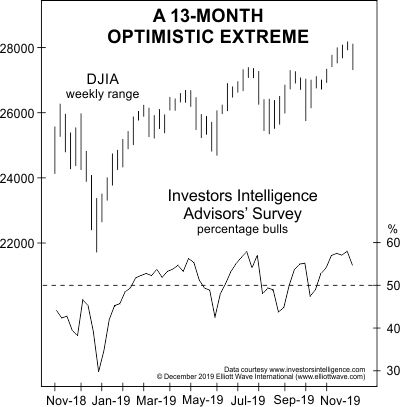Many stock market investors believe that prices have already bottomed. Numerous banks, brokers and financial firms have issued statements saying as much.
Indeed, the May Elliott Wave Theorist, a monthly publication which has offered analysis of financial and social trends since 1979, noted:
On April 28, Bloomberg interviewed four money managers to answer the question of “Where to Invest $1 Million Right Now.” Cash was not mentioned.
All these professional financial observers might be right in their assessment that the bottom is in for stocks.
Then again, the stock market rise since the March 23 low might be a bear-market rally.
If so, it certainly has “done its job,” meaning, as one of our global analysts put it in Elliott Wave International’s May Global Market Perspective (a monthly publication which covers 40+ worldwide markets):
The job of [the first, big bear-market] rally is to recreate the optimism that existed at the previous highs.
One particular sentiment that the rally has “recreated” is known by the acronym FOMO, which stands for the “fear of missing out.”
A little background: Toward the end of 2019, the FOMO sentiment was prevalent. Indeed, our December 2019 Elliott Wave Financial Forecast (a monthly, U.S.-focused publication which covers stocks, bonds, gold, silver, the U.S. dollar, the economy and more) showed this chart and said:

Last week, the percentage of bulls polled in Investors Intelligence Advisors’ Survey rose to 58.1, a new 13-month extreme. … Last month we talked about the return of FOMO, the fear of missing out on stock gains; its last major outbreak occurred as stocks approached their January 2018 highs. In November, FOMO became far more entrenched. One Bloomberg commentator called it “the age-old fear of missing out” and stated, “The end of the year is coming, when investment managers will be judged on their performance. Those who are behind have an incentive to clamber into the market now, while there is still time.” In our experience, “to clamber” is generally not a sound investment strategy.
As you know, it wasn’t long thereafter that the stock market topped. The major price moves downward were historic.
Even so, the “fear of missing out” sentiment has returned — again.
Here’s an April 7 Bloomberg headline:
FOMO Overwhelms Stock Traders Who Have Begun Ignoring the Risks
Our May Elliott Wave Financial Forecast provides more insight:
According to Google News, the number of articles referencing FOMO and “stock market” increased from 227 in December 2019 to 244 in February 2020, right through the peak in the market. In March, the market’s decline was well established, still the FOMO news count rose to 267.
So, yes, the rally has indeed “recreated” the prior optimism. One might even argue that the level of optimism is now even higher.
So, should investors take the stance that the bottom is in – or, proceed with extreme caution?
Knowledge of the stock market’s Elliott wave pattern will help you to answer that question.
As the Wall Street classic book, Elliott Wave Principle: Key to Market Behavior, by Frost & Prechter, notes:
The primary value of the Wave Principle is that it provides a context for market analysis. This context provides both a basis for disciplined thinking and a perspective on the market’s general position and outlook.
You can read the entire, online version of Elliott Wave Principle: Key to Market Behavior, free!
You only need a Club EWI membership, which is also free. Club EWI is the world’s largest educational Elliott wave community and allows you to get Elliott wave insights on investing and trading, the economy and social trends that you will not find anywhere else.
This link gets you started: Elliott Wave Principle: Key to Market Behavior, 100% free.
This article was syndicated by Elliott Wave International and was originally published under the headline Why Bear-Market Rallies Are So Tricky. EWI is the world’s largest market forecasting firm. Its staff of full-time analysts led by Chartered Market Technician Robert Prechter provides 24-hour-a-day market analysis to institutional and private investors around the world.